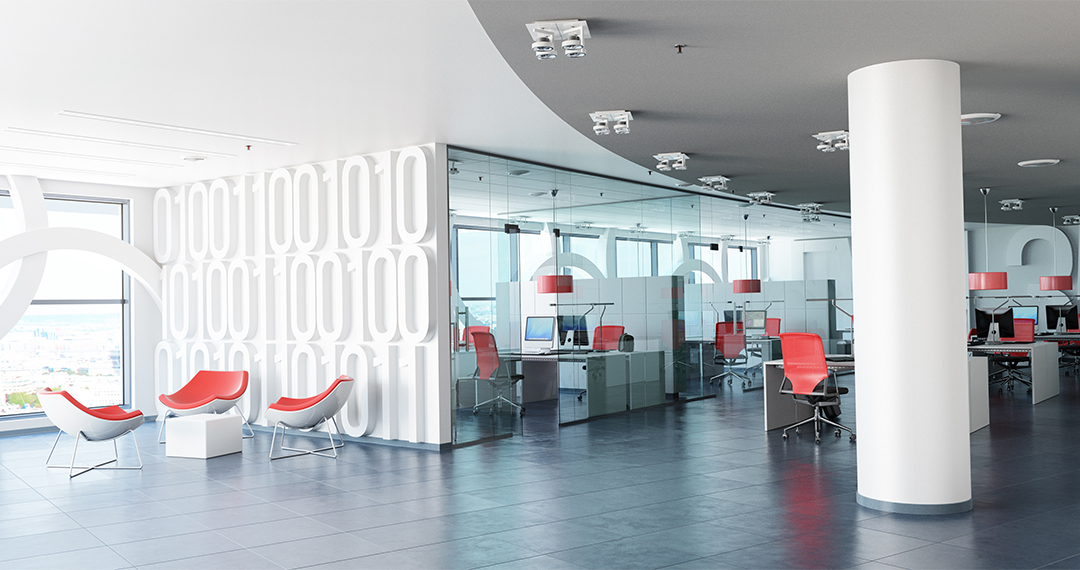The open office concept has exploded in popularity in recent years not only due to cost savings, but because it provides flexible, activity-based spaces that promote communication, collaboration, and, ideally, productivity.
Some of the world’s largest companies, like Facebook and Google, employ the open office concept and outfit large spaces with benching systems and communal areas. Removing walls is said to remove hierarchy and enhance approachability. Additionally, an open office requires less office infrastructure, which greatly reduces costs.
It must be noted, however, that open offices aren’t meant for every company. There’s a range of factors that determine if a business is the right fit for the open office. Jobs that require silence and privacy, for example, should probably not make the switch to this concept.
The ideal office concept for a business should promote productivity and boost employee health. Instead of assessing the needs of their offices, 4 out of 5 businesses choose the open office concept. Naturally, this level of adoption has led to common issues for some companies.
Common Issues with the Open Office Concept
Open office concepts work well for many companies, but those who experience issues frequently have the same problems:
Social Withdrawal & Reduced Face-to-Face Communication
Open offices are supposed to foster increased communication and collaboration, but companies often experience the exact opposite. In fact, one study showed that open offices reduced face-to-face communication by 70%.
It appears that the lack of privacy is causing workers to withdraw socially and lean on electronic interactions with coworkers through email and chat. This is especially true for younger generations joining the workforce. They’re already used to communicating through electronics, so the open concept doesn’t necessarily prompt changes to this behavior.
Excess Noise and Less Privacy
Sound travels when there’s nothing to stop it. Bringing down walls and opening an office up naturally leads to a louder environment. This isn’t inherently a problem when the goal is to promote collaboration, but collaboration isn’t necessary all the time. Employees must work alone and complete tasks, and a loud environment can make that more difficult.
Voices carry, and no walls to provide some privacy can also be an issue for workers. Some work information or conversations may be confidential, and outside lives can’t always stay outside the work environment. A lack of privacy can be problematic for workers, which is bad for business.
Lower Productivity
Collaboration is necessary for cohesiveness and success, but privacy and silence should never be overlooked. Interruptions, noisy coworkers, even the lack of an assigned workspace can hinder productivity. Business owners who are swayed by the cost savings of open offices must ensure productivity doesn’t slip after implementation, or else the savings will quickly turn to a loss.

How to Avoid These Issues
If you’re planning an office design or are considering changes to an existing open concept that was implemented, ensure you consider these four points to make the most of your space for employees and clients:
More Choices
It’s important that an open office strikes a balance between face time and privacy, and it’s vital that employees have control over this balance. The ideal open office should give workers access to spaces for collaboration, focus, socialization, and learning.
An open office shouldn’t be completely open, but should instead provide group and individual spaces to balance collaboration and focus. Providing choice is empowering and giving employees more choice is likely to improve worker morale and productivity.
Quiet Spaces
Privacy and noise levels are two common issues with open offices, which is why quiet spaces are becoming more popular. They might be located in the middle of an open office, but they use adjustable lighting, comfortable seating, and soundproofed walls so workers can use them as needed.
These spaces can provide the privacy that is sorely lacking from most open offices, so workers don’t have to hide when they have to take a personal call. They are also ideal for those who struggle to focus in loud environments.
Plan for Everyone
This might not be an issue with smaller businesses, but many companies are made up of divisions. Each division of a company might have different needs depending on the work they do. An accounting department, for example, might require more quiet zones as well as meeting rooms when collaborating is necessary.
Departments where workers communicate and collaborate all day – a marketing team, for example – might require fewer private rooms. Understanding the needs of every group or department in your business is vital to creating a successful open office environment.
Reduce Friction
Having the right ideas is good, but proper execution is even better. Using cheaper materials might not seem like a big deal, but they could cause sound to reverberate or amplify. Private rooms that aren’t fully soundproof won’t be nearly as effective as they should be. Limited meeting areas or quiet rooms could create scheduling issues that increase stress.
Properly executing these ideas will reduce points of friction in the office and improve employee health and productivity.
Short Term Fixes to Avoid a Complete Redesign
If you’ve recently transitioned to an open office or don’t have the funds for a complete redesign, there are a few ways to eliminate issues in the short term.
- Privacy Panels or Wall Dividers: If noise and privacy levels are frustrating your employees, consider adding privacy panels to work surfaces or purchasing mobile wall dividers. While these options might not be as effective as a redesign, they are proven to reduce noise levels and boost privacy for workers. Assess your open office and ask workers where the problem areas are to determine where these panels and dividers would be most beneficial.
- Whiteboards: The addition of whiteboards is a small expense that can have a large impact. If your office suffers from reduced face-to-face interactions, whiteboards could help change that. They can increase interactions by up to 50%, which is a huge leap forward for collaboration.
- Biophilic Elements: Adding biophilic design elements to your office might not help with the majority of noise and privacy issues in the open office, but they are beneficial to employees and easy to implement. Biophilia involves bringing nature into the workplace through the addition of natural materials and vegetation. The aesthetic is appealing, and it can give a completely different look to open areas while also improving employee well-being.
Open office designs aren’t for everyone, and that’s ok. If your business wants to employ the open office concept – or wants to update a current open office – you should work to ensure you’re maximizing creativity, privacy, and productivity.
If you’re having trouble with your open office, discuss your problems with an experienced office space designer at Office Furniture Warehouse. Our in-house design team can offer advice on the best type of office furniture and layout for your business, so contact us today.

